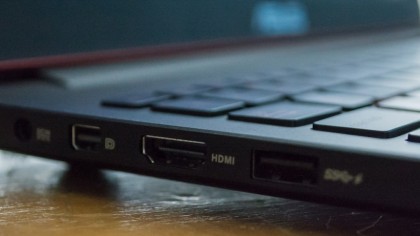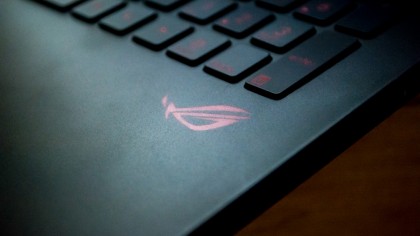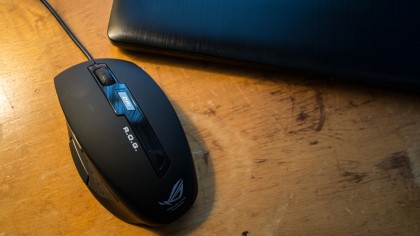Why you can trust TechRadar
Total dimensions for the Asus ROG G501 are 15.08 x 10.04 x 0.81 inches or 383 x 255 x 20 mm (W x D x H). This laptop is thin for a 15-inch gaming machine and only a hair thicker than the 15.1 x 10.6 x 0.8 inch (385 x 270 x 20.9 mm) Gigabyte P35K v3. The Asus gaming laptop, however is lighter, weighing 4.54 pounds (2.05 kg), whereas the Gigabyte's machine tips the scales at 5.07 pounds (2.29 kg).
The barely-there thickness and weight are thanks in large part to the Nvidia GTX 960M graphics card and lack of an optical drive. That said, Razer has shown the mobile gaming world how to make a truly thin and capable machine with the 2015 Blade laptop, which measures 13.6 x 9.3 x 0.7 inches (345 x 235 x 17.9 mm) while weighing in at 4.47 pounds (2.03 kg).

Spec sheet
- CPU: 2.6GHz Intel Core i7-4720HQ (quad-core, up to 3.4GHz with Turbo Boost)
- Graphics: Nvidia GeForce GTX 960M (4GB GDDR5 RAM), Intel HD Graphics 5100
- RAM: 16GB DDR3L (1,600Mhz)
- Screen: 15.6-inch, 3,840 x 2,160 UHD IPS matte display
- Storage: SATA III SSD 512GB
- Ports: 3 x USB 3.0, HDMI-out, mini DisplayPort, 2-in-1 card reader, 3.5mm 4-pole headset jack
- Connectivity: Intel dual-band wireless-AC 7260 (802.11ac Wi-Fi), Bluetooth 4.0 LE
- Camera: 720p, 1 MP webcam
- Weight: 4.54 lbs.
- Size: 15.08 x 10.04 x 0.81 inches (W x D x H)
At $1,999, the Asus G501 beats out other computers in its class for price. In addition to the configuration you see above, Asus has also packaged the machine as all-in-one kit for burgeoning gamers, throwing in a decent mouse and gaming headset to add value for the overall package. The G501 can also be purchased on its own for $1,699 (about £1,083, AU$2,122).
A comparably specced Razer Blade 2015 cost $2,399 (£2,035, AU$3,699). That's nearly the same you would pay for the G501, with an identical CPU and same amount of RAM paired with a beefier Nvidia GTX 970M graphics card. But the G501 beats Razer's machine with more storage and screen resolution (by a long shot).
The 512 GB SSD in the Asus G501 is on the high-end of luxury laptops, but it makes a necessity for today's larger crop of games, such as GTA V's whopping 65GB install. Massive games are a bigger problem on the Razer, which ships with just a 256GB SSD. Upgrading the Blade to an equivalent SSD, meanwhile, is an extra 300 bucks on top of its already steep price tag.
The Gigabyte P35K v3 comes at comparable bargain priced at $1,499 (about £973, AU$1,913). For the money, users will get the same processor and a slightly higher end Nvidia GTX 965M GPU. But in the long run you'll have the least amount of flash storage with an 128GB SSD and only 8GB of RAM, plus the screen resolution is limited to 1080p – which turns out to be better for performance than a Ultra HD display.

Performance
Games look and perform really nicely when optimized for the computer hardware, which makes the 4K display all the more pointless, since nothing but elite gaming PCs can run 4K well. The added cost really comes down to bragging rights. You pay more to tell people you have a 4K gaming laptop, but you can't really do anything 4K with it. That's like putting a six-cylinder engine in a Ford Mustang.
In fact, the best use of the 4K resolution came to Hearthstone. The G501 has no problems whatsoever running a digital card game at its highest possible settings, save for a minor drop in framerate when cards fly out of the deck. At 4K, Hearthstone is incredibly gorgeous and really brings out the quality of Blizzard's art.
It's a damn shame that more games and applications don't work as well at this bumped up resolution. In the case of Civilization: Beyond Earth, some menu screens displayed at 4K are so tiny they're nearly illegible. Other applications and alerts try to scale for the resolution with mixed results. Chrome is one exception where everything on the web browser's UI looks crisp.

Benchmarks
- 3DMark: Sky Diver: 11,854; Cloud Gate: 14,731; Fire Strike: 3,927
- Cinebench CPU: 638 points; Graphics: 93.09 fps,
- PCMark 8 (Home Test): 2563 points
- PCMark 8 Battery Life: 3 hours and 6 minutes
- Middle Earth: Shadow of Mordor (1080p, Ultra): 28.3 fps (1080p, Low): 56.81 fps
- Metro: Last Light (1080p, Ultra): 15.33 fps; (1080p, Low): 65.67 fps
The G501 falls short of its contemporaries, the Razer Blade 2015 and Gigabyte P35K v3, in all three 3DMark tests. In fact the ROG laptop is behind in every test except for Cinebench, where the G501 just squeaks by the P35K's 629 CPU score.
At 28.3 frames per second (fps), the G501 faltered under the strain of the Middle Earth: Shadow of Mordor benchmark test, once again falling behind the other two laptops. It's a bit expected, as the G501 is running on an Nvidia GTX 960M, whereas the P35K v3 has a Nvidia GTX 965M and the Blade is packing a GTX 970M.

Squeaking by at 4K
It's not just games running 4K that tax the machine, the few bits of 4K content on YouTube suffer similarly. My internet connection is fully capable of the speeds needed for 4K and Ultra HD content, and yet videos still stutter along. The G501 struggles to push all those pixels and videos chug along with their gorgeous visuals intact, but stripped entirely of fluidity.
Even static images at 4K suffer. Images on Flickr viewed at their full resolution look phenomenal, with fantastic color reproduction and sharpness. On the high-res screen, digital photos have parity with their printed counterparts. However, loading an image takes longer than it feels like it should. For kicks, I also tried editing some of my own photos in Adobe Lightroom. Sadly, the process is so intense that even cropping RAW photos at 4K was too much for the G501 to handle.

Too many pixels to love
The quality of the display itself is nice enough, with a decent 282 ppi and accurate color reproduction. The 700:1 contrast ratio, however, isn't great for discerning dark details. The matte finish also catches any background light, whether it be from a lamp or a sunlit window, spreading it across the screen.
As such, I would definitely recommend against using the machine outside. Even tucked away in a shady hiding spot, any natural light hitting the screen washes it out and makes it difficult to see anything.

Peripherals save the day
One of the biggest disappointments are the G501's speakers. There's no way to sugarcoat it: they are bad. The sound quality is comparable to the built-in iPhone speaker, but in stereo. It's very tinny, flat and is so out of place with the rest of the computer that it's jarring.
Games start up, displaying gorgeous visuals but terrible sound – the contrast between the two breaks the experience. Thankfully, Asus recognized this flaw and includes a Cerberus gaming headset (along with an ROG GX850 gaming mouse) in the box.
These are no simple earbuds, either, they're honest-to-goodness, over-ear headphones with a detachable mic. They don't give the same booming base as a high-end gaming headset would, but they're an enormous improvement over the built-in laptop speakers and more than adequately get the job done. And as an added bonus, since the connector is a standard 4-pole pin, the set plugs into your phone or any other device with a 3.5 mm jack.
Another area where the computer falters is its trackpad. It just doesn't feel accurate or snappy, but once again Asus has the solution packed in the box. Since a trackpad makes gaming pretty difficult, the included gaming mouse is a welcome touch. Like the headphones, it's not really comparable to a dedicated, high-end gaming mouse, but it works admirably.
Together, the headset and mouse are fine additions to the overall package. Of course, if you'd rather get your own peripherals, there's always the option to buy the laptop on its own and outfit it with extras as you see fit.
Battery hog
As far as battery life goes, the G501 lasted for a middling 3 hours and 6 minutes on the PCMark8 benchmark test. This places it in the middle of the other two laptops; with the P35K v3 clocking out after 3 hours 33 mins. The Blade, meanwhile, falls short of the three hour mark by a full 29 minutes.
Even with a basic round of everyday tasks including running Skype, Spotify, Chrome, plus a handful of Hearthstone games while the screen was set to its maximum brightness, the Asus ROG G501 only lasted for 30 minutes more. By comparison, the Gigabyte P35K v3 ran for a very similar 3 hours and 40 minutes. The Razer Blade tails closely with 3 hours and 43 minutes of battery life.
